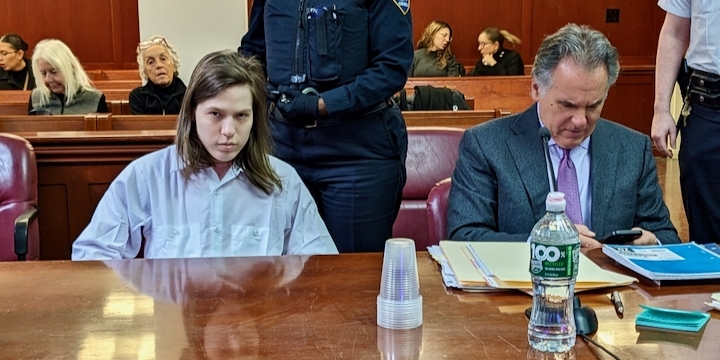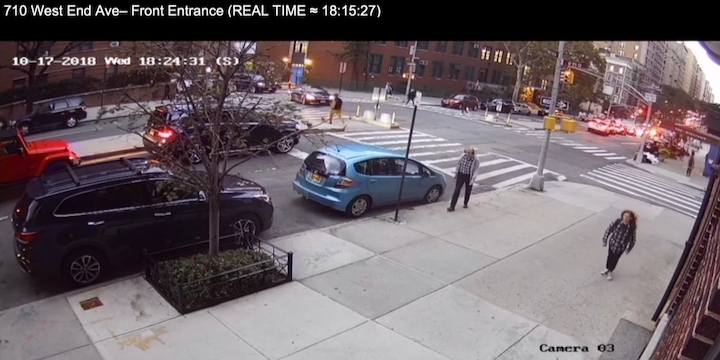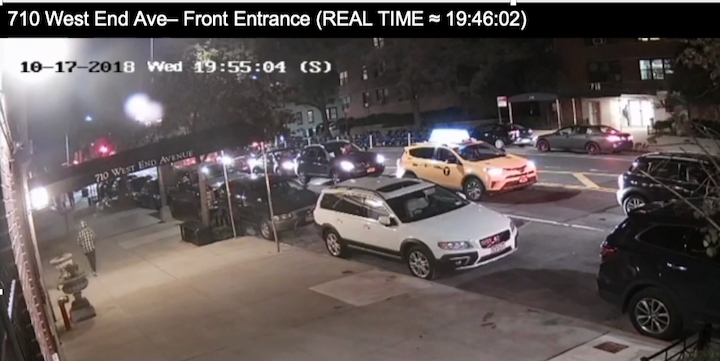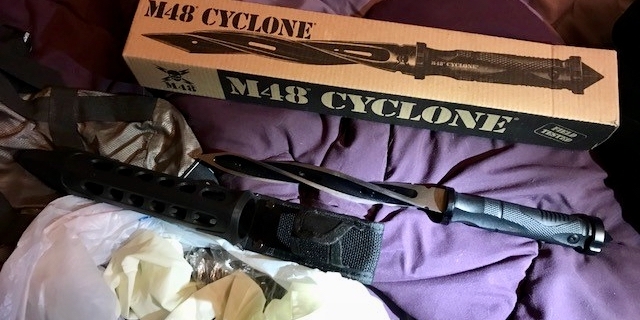
By Joy Bergmann
On Monday, a Manhattan jury found Anya Johnston, 29, guilty of second-degree murder for the October 17, 2018, stabbing death of her neighbor Susan Trott, rejecting an insanity defense presented by Johnston’s attorney.
Johnston did not visibly react as the verdict was read. Her mother, also in the courtroom, sat silently as well.
Judge Ruth Pickholz is scheduled to sentence Johnston on May 1, when she could receive a prison term between 15 years to life.
Susan Trott’s longtime friend and business partner Eric Boscia expressed relief at the verdict. “I feel a big weight off my shoulders knowing justice has been served,” he said in a call with WSR. “It’s been such a long, surreal experience.”
The trial offered a window into Johnston’s mind and clinicians’ struggle to understand and diagnose her mental condition. Testimony from 19 witnesses – along with more than 50 exhibits – also illuminated the timeline of events leading up to and following the death of Trott, who was 70.

Dueling Expert Opinions
Prior to trial, two forensic psychiatrists interviewed Johnston to evaluate her mental state. They reviewed thousands of Johnston’s medical records from long before, contemporaneous with, and after the murder. And they read Johnston’s diary. Their expert assessments – documented in lengthy reports admitted into evidence and discussed during their testimony – came to very different conclusions as to whether Johnston should be held responsible for the crime.
Dr. Eric Goldsmith, the defense’s expert forensic psychiatrist, testified that, on the night of the murder, Johnston was in a “very disturbed, psychotically depressed state of mind,” had “lost touch with reality,” and met diagnostic criteria for schizoaffective disorder. Because of her serious mental illness, Goldsmith believed she “lacked substantial capacity to appreciate that her conduct was wrong,” and should be found not responsible.
The prosecution’s forensic psychiatry expert Dr. Jason Hershberger refuted that assessment, calling Johnston “a psychopath” who had been “preoccupied with violence and homicide for years,” and, when she fatally slashed Trott in the neck, she knew what she was doing, and knew it was wrong. He added that he believed Johnston was either “indifferent to…or actively enjoyed the wrongfulness” of killing Trott.
Hershberger pointed to 2018 medical records documenting how Johnston “objectively lacked psychotic symptoms” like hallucinations or delusions. He believed a better diagnosis to be borderline personality disorder, antisocial personality disorder, and unspecified depressive disorder – mood disorders that do not incapacitate at a level meeting the insanity defense standard in New York. Hershberger believed Johnston should be held responsible for the murder.
Complex Psychiatric History
Attorneys for both sides presented excerpts from Johnston’s treatment records from her preschool days up through her current stay on Rikers Island.
These records showed that, over the past decade, Johnston has attempted suicide at least six times and was hospitalized after each attempt. From age 11 until days before the killing, Johnston saw an Upper West Side neuropsychologist for therapy at least once a week.
Throughout her decades of treatment, however, psychiatrists disagreed on Johnston’s primary diagnosis, pegging her with various depressive disorders, ADHD, bipolar disorder, generalized anxiety disorder, schizoaffective disorder, borderline personality disorder, and more.
But Assistant District Attorney Harrison Schweiloch focused jurors’ attention on Johnston’s Mount Sinai West emergency room record for October 18, 2018, when she was evaluated as a suicide risk just a few hours after the murder, but days before police found Sue Trott’s body. Emergency room doctors, who did not know about the killing, described Johnston as “calm, cooperative, with clear speech, and euthymic affect [good mood].” They found Johnston did have suicidal ideation and a plan to act on it, but no evidence of paranoia, delusions, or hallucinations. Their diagnosis: Borderline personality disorder.
Johnston’s Disturbing Diary
Johnston did not take the stand at her trial. But readings from her diary – spanning from November 2016 until two days before the murder – revealed a turbulent inner life.
In the diary, she expressed hatred for her adoptive mother and contempt for clinicians, saying she had fooled them into believing she was complying with treatment. She described herself as “lonely” and alienated, engaging with people only “as tools.” In writing that she had to mask her true self at her job as a Symphony Veterinary Center assistant, Johnston said: “I have enough social skill and awareness to act and be seen as relatively normal, but I really am a monster.” Diary entries also expressed a longing for death, describing suicidal-homicidal fantasies including the “BEST DREAM EVER” about injecting people with a pet-euthanizing solution before turning the needle on herself.
In 2018, Johnston’s diary entries began to describe an action plan. “I have made the Decision…That one will die, as I do,” she wrote. She named the month – October – and said she felt a “relentless calm,” about her mission, adding: “If you insist on getting in my way, I’ll kill you.” Johnston wrote that she had “a blade and oh god you better believe I WILL use it.” In the diary’s last line, written two days before the murder, she hints at one other to-do item. “I cannot WAIT to rip you apart lady, it’s gonna be beautiful.”
Johnston never mentioned Susan Trott in the diary, nor did Trott’s name appear in therapy notes or medical records or in conversations recalled by Johnston’s co-workers who testified at the trial.

Why’d She Kill Sue?
According to witness testimony, trial exhibits, and her interviews with the evaluating forensic psychiatrists, Johnston had decided to jump off the Brooklyn Bridge on the night of October 17, 2018. She’d taken laxatives for three days prior to prevent soiling herself upon death. And she’d put a M48 Cyclone dagger and a smaller knife – both purchased on Amazon months earlier – in her backpack. The weapons were to fend off any Good Samaritans who tried to stop her from jumping.
Johnston spent that Wednesday afternoon running errands on the Upper West Side: closing a TD Bank account, purchasing bead glue at Michael’s, and picking up fresh berries at Whole Foods.

By 6:15 p.m. she was back home at 710 West End Avenue but, “didn’t want to be by myself at home…I just needed a distraction,” Johnston told the evaluating forensic psychiatrists in interviews recounting her thoughts and movements that day.
Johnston took her backpack and went looking for company. She first stopped by a couple’s apartment on the 12th floor; she used to cat-sit for them. But they weren’t home.
Johnston then thought of Susan Trott, whom she knew was another kindhearted animal lover. The two didn’t have a relationship beyond being neighbors since the day in 1997 when Isabel Johnston adopted almost-three-years-old Anya from a Russian orphanage.
According to Johnston’s retelling, Johnston knocked on the 14th-floor door and Trott welcomed her in. They chatted in the living room about work and pets and life. Johnston mentioned her plan to end hers. Alarmed, Trott told Johnston she mustn’t do that, too many people cared about her. Trott said she would get Johnston some help.
Johnston became enraged. No one was going to thwart her suicide plan.
As Trott turned away, perhaps looking for her phone, Johnston plunged the cyclone dagger into her lower back. Trott let out a small scream and tried to fight back. Johnston then slashed Trott’s neck, severing her jugular vein and carotid artery as well as her windpipe, leaving her unable to breathe and bleeding profusely. She died moments later.
Johnston then dragged Trott’s body into the bedroom and shut the door. As she left the scene, she locked the apartment door, something Trott never did in her decades of living in the doorman co-op. Johnston headed to her 15th floor apartment, leaving a trail of bloody footprints behind her.
There, prosecutors said, Johnston washed herself and the dagger, carefully putting it back in its original sheath and box, and put it in her backpack. She made her way down to the first floor stairwell and left the backpack there.


She left the building at 7:46 p.m. and went to the Brooklyn Bridge.
But doubts crept in.
Johnston told the evaluating forensic psychiatrists that, while on the bridge, she realized she didn’t want to leave her mom or her cat Sammi, whom she loved, but had also severely abused.
She called her mother, told her what she had been planning, and promised to come home. Isabel summoned the NYPD to be in the apartment when Anya arrived at 11:12 p.m. They would ensure her safe transport to Mount Sinai West for evaluation.
A Surreal NYPD Encounter
Johnston didn’t flinch or flee when she discovered uniformed officers in her home. She didn’t know if they knew about Trott’s body downstairs. (They didn’t yet.)
In NYPD body-worn-camera video footage shown during the trial, Johnston appears calm and quiet. She answers some of the police questions about how she spent her day, but does not respond when an officer inquires about some scratches on her face.
At one point, Johnston is heard saying: “I want to get my backpack. It’s downstairs on the first floor.” After an officer retrieves it, Johnston takes the backpack into her kitchen, removes the berries from Whole Foods, and puts them in the refrigerator.
Security cameras showed Johnston and EMTs leaving for the hospital at 11:35 p.m.
Upstairs, her mother and police searched her backpack, worried she might have hoarded pills or something else to harm herself, an NYPD officer testified. They discovered the cyclone dagger, a smaller knife, and latex gloves.

Only on the following Sunday morning would their significance become clear when the NYPD discovered Sue Trott’s body after her business partner Eric Boscia called and requested a wellness check.
Two weeks later, on October 30, 2018, officers arrested Anya Johnston in the hospital.
And five and a half years after that, seven women and five men found her guilty of second-degree murder.

If you or someone you know is thinking about suicide, counselors are available 24/7 to listen and provide support. Call or text 988 to reach NYC’s Suicide & Crisis Lifeline.
Subscribe to WSR’s free email newsletter here.









Great reporting – thank you for the very detailed (and sad) story.
Very sad that Ms. Trott was murdered for trying to stop someone from committing suicide.
It seems like the jury pretty clearly got this one right. I hope she never walks the streets again.
Bar for not guilty by reason of insanity is quite high in NYS. That defence is more often than not unsuccessful historically far as many accused go.
As a clinician, there is no such thing as a “psychopath.” Dr. Jason Hershberger is either misquoted or misinformed. It is a meaningless pop-psychology term. A clinical diagnosis is not a moral judgment, and there is no place in medicine, the court or elsewhere for the term “psychopath”
You’re a little late in the game for these proclamations. Of course there is such a term as psychopath. You just don’t want to know it or believe it, because it’s not scientific, based on your definitions of science. But for the majority of people not dealing in science, it’s not meaningless at all. It’s a sociopath who crosses over into physical violence and depravity. Crime isn’t about medicine, really. It’s indeed about moral judgements, and laws made by man to regulate society. And of course, the term belongs in Court. Court is where we hold people responsible for their actions to safeguard society. The bottom line is this woman knew what she was doing and that it was wrong and harmful. She was so aware that when it came time to harm herself, she backed out of it. That’s pure narcissism. Many cases wind up that way — people who kill their families and then back out of killing themselves and wander away and start a new family, such as John List. Narcissistic psychopaths. The term works for me.
Dr. Hershberger is misquoted. Correction should be: “antisocial personality disorder with sadistic features”
Thank you for reading. During his courtroom testimony on February 26, Dr. Hershberger referred to Johnston as a “female psychopath.” He also used the DSM5 clinical language and detailed his diagnoses mentioned in the story: borderline personality disorder and antisocial personality disorder.
The point was previously being made by the above self-identified clinician that Dr. Hershberger was using language he should not have been given his expert status in forensic criminal psychiatry because it is not found in the DSM-5. My point is that he
was attempting to make the jury understand what sociopathy, antisocial, BPD etc. meant in layman’s terms so the jury could comprehend what all these diagnostic terms mean, while also providing an actual clinical diagnosis found in the DSM5. He never said “I think she’s a psycho” as if it was his actual diagnosis. Quoting him saying “psychopath” is a tad on the salacious side to grab a reader’s attention so probably should have had additional clarification so the doctor doesn’t appear to be improperly using medical terminology.
I knew Sue Trott and I am not surprised that she tried to help Anya in what turned out to be her final moments. I saw Sue tame and sweet-talk even the most terrifying pit bulls. Unfortunately, Anya was more vicious than any of the abused animals that Sue ever cared for. That Anya managed to rip out Sue’s beautiful soul and stop her caring heart from beating is the epitome of evil. Joy, thanks for bringing the truth to light. And for telling Sue’s story.
I am so sorry this happened to your friend. By all accounts, she was a lovely person.
My heart breaks for her and her friends and family. I’m so sorry this happened to your friend.
This is a very disturbing story. I appreciate the detailed reporting from West Side Rag.
Why are daggers available for purchase on Amazon?
Thank you Joy. I knew Sue from the neighborhood having met walking our dogs. At one point Ms. Johnston was on a ledge outside of her apartment, wrapped in a sleeping bag. Police got her back inside. About a week before the murder, I asked Sue if Ms. Johnston was ok? She replied yes. So so sad.
5 1/2 years is way too long, and 15 years to life is way too lenient.
With respect to the use of ‘psychopath’, I agree with Dr. Hershberger.
Obviously this person should be incarcerated for the rest of her life in the interests of public safety.
It’s disturbing that it took 5 1/2 years to get this verdict.
Said this before and am doing so again; remember Covid pretty much shut down NYS for about two years. This included much of the court system.
Even without pandemic it can take three, four or more years for felony cases to play out (from arraignment to trial then verdict). Pile on “insanity defence” and that only increases amount of time due to required examinations, gathering of evidence, investigation into past mental history…
One of reasons for “bail reform” and other criminal justice actions in Albany and from city hall is to stop or cull number of persons held in jails, for often several years, until their trail begins and concludes.
Covid did NOT shut down NYC for two years. Schools were open, police and firefighters were working, grocery stores were open, banks were open and the list goes on.
The NYS court system *was* slowed down for a significant time during COVID. That probably contributed to the delay. So did the psych evaluations.
Thank you!
Cuomo using “Pause” laws shut down virtually entire state including court system for several weeks early in pandemic. Then everything had to be reimagined or reworked as court system like everyone else dealt with pandemic.
https://www.nysda.org/page/Coronavirus2020CourtRe-OpeningPlans
Yep, I had cases going in state court at the time so I certainly remember.
Thank you for giving us such an in-depth report
I remember seeing photos of the bloody footprints leading from Trott’s apt. to Johnston’s apt. And it was mentioned here in this article. So why would it take ANYONE 4 days to discover Trott’s body???
Thanks for reading. In WSR’s previous story about the first day of trial, an NYPD officer explained how the footprints were visible inside Trott’s apartment, but grew fainter as they traveled up to Johnston’s apartment. NYPD used luminol to highlight the footprints trail.
Here’s that story link: https://www.westsiderag.com/2024/01/26/anya-johnston-murdered-susan-trott-but-she-was-crazy-defense-attorney-says-in-trial-opener
She lived alone and people go on vacation all the time.
There was also theoretically a path of blood between the two apartments so I think the poster is asking how none of the neighbors, building staff, etc. noticed that.
There was absolutely no “path of blood.” Her footprints were detected only when the lights were all turned off and a blue light was used—there must have been a small amount of blood on her shoes that dried in the days before the investigation. In addition, the hallway floor is a tile mosaic in dark browns and reds (not my favorite!), and so it could be hard to see small amounts of dried blood.
She bought the dagger to stop people preventing her from committing suicide, then purposely sought out company and shared her plans? That was an elaborate excuse. It sounds like killing Susan Trott was her plan all along.
Good for the jury for not falling for it.
What happen to Susan is beyond tragic.
But how can Anya been deemed responsible? Suicidal person with lengthy mental illness history is sentenced to jail? She should have been institutionalized long time ago, but no, we don’t do that because of “rights”, but to throw mentally ill person to jail is ok.
You do the crime –
You do the time.
I’m not sure it was apparent to those treating her beforehand that she was a threat to others or even an ongoing threat to herself (we don’t permanently institutionalize everyone, or even most people, who attempts suicide).
As someone else noted above, the standard for an insanity defense in NYS is quite high, almost impossible to achieve with establishing contemporary psychosis. That you may not be in control of yourself doesn’t matter. That you’re doing something that basically makes no sense–killing a stranger, with no motive that makes sense–doesn’t matter. Clearly she has to be kept locked up now and forever, but a secure psychiatric facility would be a more appropriate choice than state prison, where it seems likely she will either succeed in another attempt at killing herself, or kill someone else, or possibly both.
A tragic, horrible story, almost beyond human comprehension. I hope Susan’s loved ones can find peace.
Thank you for such a detailed report — this article is the most extensive I’ve seen thus far. The inner workings of her mind is most fascinating (and terrifying) to me.
Truth be told, I know Anya and I also knew the lovely Sue Trott, as I lived in the same building. What a horrific tragedy for Sue to be wiped off the face of the earth so violently; Sue was kind, generous, a little wacky (but what New Yorker isn’t?), and supremely caring.
While I am a bit confused as to why Anya was charged with second-degree murder (and not first-degree), I sincerely hope she will be behind bars for the rest of her life. And while I’m sure her mother Isabel is sad about all of this, I hope she can live a happy life without her daughter–perhaps this can be a new chapter for her.
https://www.nysenate.gov/legislation/laws/PEN/125.27 In NYS, murder in the first degree applies to: murder for hire; murder of a police office, prison guard, judge, first responder, witness, etc.; during the commission of certain other crimes; accompanied by torture.
Good point.
An adoption at a young age, not newborn, from a Russian orphanage has been a note in a number of violent crimes that I’ve come across in news sources.
Very sad.
So many different diagnoses of the perp over so many years speak to the contemptible state of psychiatry. It really should be banned.